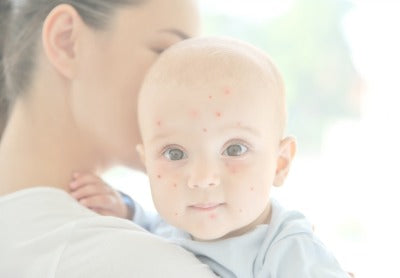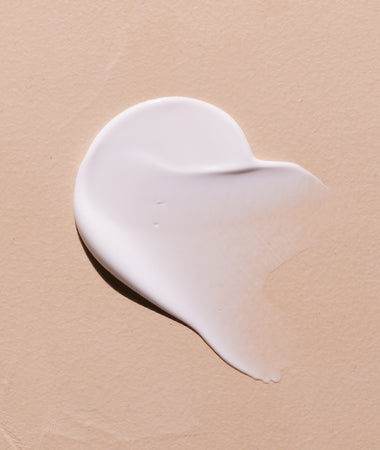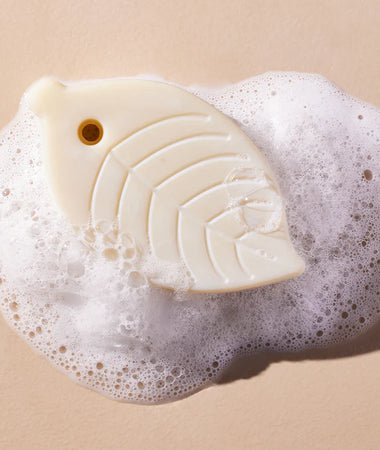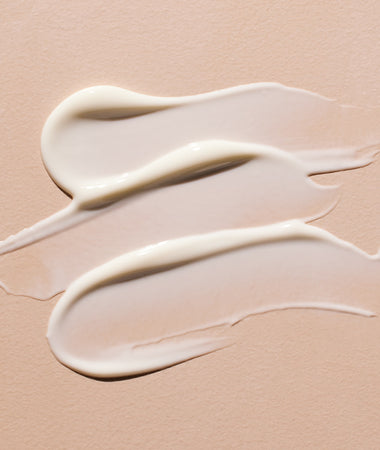
Baby Chicken Pox: The Complete Guide For Parents
Even though baby chicken pox is a common childhood illness, as a parent, it’s hard to see your little one sick and uncomfortable. And while chicken pox is not typically a huge cause for concern, it can be overwhelming if you’re not sure what signs to look for or how to treat baby chicken pox.
But with the right information about the illness and a few tips on how to keep your child comfortable while they have it, both you and baby will rest a bit easier!
Whether you suspect that your baby has a case of the chicken pox or you’re just preparing for the possibility, the experts at Mustela have the information you’re looking for.
What Is Baby Chicken Pox?
Baby chicken pox, scientifically known as the varicella-zoster virus, is a common childhood illness characterized by itchy red spots. It’s a contagious virus that typically affects children between the ages of two and ten, although adults and very small babies can also catch it.
Other than the unrelenting itchy spots, what are the symptoms of baby chicken pox? The illness begins with a fever a couple of days before the red spots appear.
Older children may complain of a headache and muscle ache, but your baby’s symptoms may include coughing, eating poorly, fussing, and sleeping more than usual.
The rash typically appears first on the face and torso and afterward may spread to the rest of the body.

Baby chicken pox is, of course, most famous for red, itchy spots. The spots usually develop in three phases: they begin as small red dots or bumps that later turn into blisters, which eventually break open and scab over.
The rash often comes in waves, which means that you may see all three phases on your little one’s body at one time.
Is Baby Chicken Pox Contagious?
The chicken pox virus is highly contagious and is spread through direct contact like coughing, sneezing, or exposure to fluid from the blisters. Your baby is actually contagious before the rash even appears, and they will be contagious until every blister is dry.
If you think your little one has been exposed to another child with baby chicken pox, it might be days before he or she starts showing symptoms. The rash usually begins 10 or 20 days after exposure to the virus.
As we mentioned, baby chicken pox is usually not a big concern, although some cases are more serious than others. The important thing in a typical case of chicken pox is to keep the blisters from getting infected.
If your little one has chicken pox in addition to baby eczema, they might have a more severe case of chicken pox and may be more likely to develop an infection.
That being said, we’ve got some good news about baby chicken pox. While it’s highly contagious and horribly itchy, your child will only get this illness once in their life! But in the meantime, how can you treat and care for a child with chicken pox?
How To Treat Baby Chicken Pox
You can get the upper hand on baby chicken pox by vaccinating your child, but you’ll have to wait until their first birthday. The chicken pox vaccine consists of two injections — one between 12 and 18 months of age and the second around four or six years old.

If your child does get baby chicken pox, let your pediatrician know and be sure to contact them if the virus worsens. The virus itself is not treated with antibiotics, but if your baby develops an infection from the blisters, antibiotics may be prescribed.
While there’s not much to do other than wait out a case of the chicken pox, we’ve got eight things you can do to relieve itching, keep your baby from scratching, and avoid infection.
1) Relieve Itching With A Natural Ointment
One great way to provide your itching child with some relief is by applying Mustela’s Cicastela Moisture Recovery Cream. This versatile cream provides immediate and long-lasting soothing comfort for itchy areas.
In addition to coming in handy for chicken pox relief (just remember not to apply it to oozing areas), it’s great to have on hand because you can also use this skin-repairing ointment for bug bites, redness in the diaper area, scratches, and scrapes.
Plus, it’s safe to use from birth on.

2) Trim Fingernails
Chicken pox care is about managing the itch and avoiding infection. One way to ward off infection is to keep your baby’s fingernails trimmed short and their hands (and fingernails) clean.
The chicken pox blisters will likely pop on their own, but it’s important to avoid scratching them open, which just increases the chance of infection. Whether you trim your little one’s nails with baby fingernail clippers or an emery board, keep fingernails short while they’ve got the chicken pox.
3) Put Sock On Your Baby’s Hands
Covering your baby’s hands is a great alternative if you just can’t seem to cut their fingernails short enough or simply want some extra scratch protection. Slide socks or mittens onto their hands during the day or while they sleep at night to avoid scratching.
4) Dress Your Baby In Loose Clothing
Dressing your baby in the correct clothing can help prevent infection as well as relieve itching. Make sure they’re dressed in loose, light clothing. If baby is too hot, it could make the itching worse.
Also, be sure that the fabric is smooth and comfortable.
Consider special clothing like Stelatopia Skin Soothing Pajamas. These comfortable pajamas are made specifically for babies with eczema, which means they’re designed to reduce the desire to scratch and improve skin comfort — exactly what your little one needs when trying to sleep with baby chicken pox.

In addition to choosing the right clothes for comfort, making sure your baby is always in clean clothing can help keep the chicken pox blisters from getting infected. You may also want to consider changing their bed sheets every night.
5) Put Your Baby In The Bath
Baths can go a long way toward reducing itchiness as well as keeping your child occupied (and not scratching!).
To get the most out of the anti-itch bath, choose a baby bath product designed specifically to soothe itchy skin or make your own by adding either baking soda or powdered oatmeal to the bathwater.
6) Pat Skin Dry After Bath Time
While baby has chicken pox, you’ll want to think twice about rubbing them with a cozy towel after bath time. Instead, gently pat their skin dry to avoid bursting the blisters.
7) Keep Baby Hydrated
Making sure your baby is properly hydrated will help keep them healthy during their bout of chicken pox.
If you’re having trouble getting your child to drink enough, get creative with fluids and consider making your own healthy popsicle out of frozen juice. Popsicles will also be soothing for children who have chicken pox sores inside their mouth.
8) Control Fevers With Acetaminophen
If you want to control your child’s fever with medication or if their blisters are especially painful, make sure you’re giving them the correct medicine.
Children with baby chicken pox should never take aspirin because it makes them more susceptible to a condition called Reye’s syndrome, which affects internal organs. Instead, give your child an appropriate dose of acetaminophen.
Note: always talk to your pediatrician about the correct dose for your baby before giving any medication.

Taking a few steps to keep your little one comfortable and infection-free will make a big difference when they come down with baby chicken pox. Remember these eight tips, keep Cicastela Moisture Recovery Cream on hand, and be sure to show baby some extra love. In no time, chicken pox will be a thing of the past!
- reg.
- $18.00
- Sale price
-
$18.00
- reg.
-
reg. $18.00
- Unit price
- /per
- reg.
- $22.00
- Sale price
-
$22.00
- reg.
-
reg.
- Unit price
- /per
Suggested Articles

The Characteristics Of Your Baby's Sleep

The Secret Of Baby Skin

Protecting Your Baby's Skin In The Winter
Get tips, news
and exclusive offers







